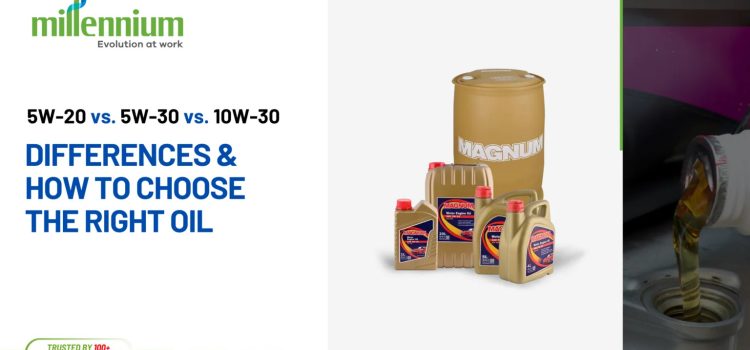
Engine oil is often referred to as the lifeblood of your vehicle. Its primary function is to reduce friction, regulate temperature, and protect engine components from wear and damage. Among the many oil grades available, 5w 20 vs 5w 30 vs 10w 30 are some of the most commonly recommended for passenger vehicles. But what sets them apart, and how do you choose the one that’s best for your car? This guide explores the key differences and helps you make an informed decision.
Understanding Engine Oil Grades
Engine oil grades indicate how the oil behaves under different temperature conditions. These grades are assigned by the Society of Automotive Engineers (SAE) and are designed to help consumers identify the viscosity characteristics of the oil. Multigrade oils like 5W-20, 5W-30, and 10W-30 are formulated to perform consistently across a broad range of temperatures, making them suitable for year-round use in most climates.
What Do the Numbers and Letters Mean?
Oil labels like 5W-20 consist of two numbers separated by the letter “W,” which stands for winter. The number before the “W” reflects the oil’s viscosity at low temperatures, or how easily it flows when cold. The number after the “W” represents the oil’s viscosity at high engine temperatures.
-
Lower first numbers (e.g., 5) mean better cold-weather flow.
-
Higher second numbers (e.g., 30) indicate better protection at high temperatures.
This grading system ensures that the oil offers sufficient protection during cold starts while maintaining proper lubrication when the engine is hot.
Why Viscosity Matters for Your Engine
Viscosity affects how quickly oil circulates and protects engine parts. Thin oils (low viscosity) flow faster, offering quicker protection in cold starts but may thin out at high temperatures. Thicker oils maintain better film strength under heat and pressure but may circulate more slowly in cold weather.
Choosing an oil with the right viscosity ensures optimal engine performance, better fuel economy, and extended engine life. Using an oil that’s too thick or too thin for your engine’s design can result in increased wear, reduced efficiency, or even long-term damage.
What is 5W-20 Oil?
5W-20 oil is a low-viscosity oil that performs well in cooler climates and is often recommended for modern engines built with tight tolerances. Its thin consistency helps the oil circulate rapidly during startup, reducing wear on internal components.
Key Characteristics:
-
Provides quick lubrication in cold starts
-
Ideal for short trips and stop-and-go traffic
-
Often used in fuel-efficient engines
-
Suitable for colder regions
This grade is typically recommended for newer vehicles with advanced fuel efficiency systems.
What is 5W-30 Oil?
5W-30 oil offers slightly higher viscosity at operating temperatures compared to 5W-20, providing a bit more film strength and high-temperature protection. It still flows easily during cold starts but offers added durability under load.
Key Characteristics:
-
Balanced viscosity for mixed driving conditions
-
Suitable for light trucks and passenger vehicles
-
Performs well in moderate to warm climates
-
Common in a wide range of car makes and models
5W-30 is a dependable all-season oil that many automakers recommend as a default option.
What is 10W-30 Oil?
10W-30 oil is thicker than both 5W-20 and 5W-30 at low temperatures, meaning it may not flow as freely during cold starts. However, it provides enhanced protection at high temperatures, making it well-suited for older engines or vehicles under heavy load.
Key Characteristics:
-
Greater high-heat resistance
-
Ideal for hot climates and older engines
-
Commonly used in high-mileage vehicles
-
Slightly slower cold-start circulation
If your vehicle operates in extreme heat or under heavy towing or hauling conditions, 10W-30 might be more appropriate.
Comparing 5W-20, 5W-30, and 10W-30
Each oil grade has its strengths depending on the vehicle type, climate, and driving habits.
-
5W-20 is best for newer engines, better mileage, and colder climates.
-
5W-30 offers balanced performance in various temperatures and loads.
-
10W-30 provides added protection in hot weather and older engines.
Though similar in some ways, these oils are formulated for specific operating conditions. Choosing the wrong grade may lead to premature wear or poor fuel efficiency.
Temperature Range Suitability
-
5W-20: Performs best in temperatures from sub-zero up to moderate warmth. Excellent for winter use.
-
5W-30: Versatile in both cold and warm conditions, ideal for regions with fluctuating temperatures.
-
10W-30: Designed for hotter climates where cold starts are not a concern.
Always consider your local climate. Using a 10W oil in a very cold region can make startups sluggish, while using 5W-20 in extreme heat may not offer enough protection under stress.
Fuel Efficiency Differences
Thinner oils like 5W-20 create less resistance in the engine, helping to improve fuel economy. That’s one reason why many automakers recommend it for vehicles designed with low-emission and fuel-efficient systems.
5W-30 also performs efficiently but offers slightly more protection at a minor cost to fuel economy. 10W-30, being thicker, may reduce fuel efficiency slightly but is better suited for longevity in demanding conditions.
Engine Protection and Wear
-
5W-20 provides quicker protection during cold starts but may not offer the same high-temperature protection as thicker oils.
-
5W-30 balances cold-start performance with better heat resistance, making it ideal for average drivers.
-
10W-30 is best for high-mileage or high-load engines that need extra protection during high-temperature operation.
If you’re driving in high-stress conditions—like towing, racing, or heavy commuting—a thicker oil can be beneficial.
How to Choose the Right Oil for Your Vehicle
-
Follow the Manufacturer’s Recommendation: Always start with what’s listed in your vehicle’s owner’s manual.
-
Factor in Climate: Use lower “W” oils in colder areas and higher-viscosity oils in warmer regions.
-
Consider Engine Age: Older engines or those with high mileage may perform better with 10W-30.
-
Evaluate Driving Conditions: Stop-and-go traffic, towing, or mountainous terrain may require more robust oil like 5W-30 or 10W-30.
-
Check for Oil Certifications: Look for API and ILSAC standards to ensure compatibility and quality.
Conclusion
The right engine oil can make a big difference in your vehicle’s performance, fuel economy, and longevity. Whether it’s 5W-20 for efficiency, 5W-30 for versatility, or 10W-30 for durability, your choice should be based on your vehicle’s needs, the climate you drive in, and how you use your engine. When in doubt, refer to your car’s manual or consult a trusted mechanic to ensure your engine gets the protection it deserves.








